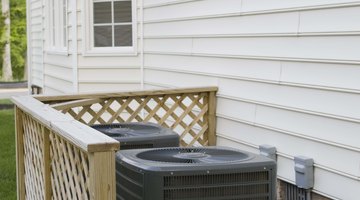What Does a Negative Sub-Cooling Number Mean in HVAC Troubleshooting?
As with any highly technical field, the world of heating, ventilation and air conditioning, or HVAC, maintains a strange language all its own.

Two phrases that appear regularly in this language, “subcooling” and “superheat,” relate directly to the way cooling systems exploit the properties of refrigerant to generate cold air. Understanding a negative subcooling value in an HVAC system requires an understanding of both subcooling and superheat.
Subcooling
The term subcooling applies only to solids and liquids and refers to the act of cooling a material below its saturation point. Saturation point refers to the temperature at which a material changes from one state to another. For instance, at sea level, water boils at 212 degrees Fahrenheit. Removing heat from water at a temperature of 212 degrees constitutes subcooling. So, cooling water from 212 to 211 degrees requires 1 degree of subcooling. In HVAC systems, subcooling refers to cooling refrigerant below its vaporization point.
Negative Subcooling
The act of subcooling generally generates positive values. For instance, cooling water from 212 to 211 degrees Fahrenheit involves a subcooling value of positive 1. However, HVAC systems sometimes post negative subcooling values, which indicate a move in the opposite direction of standard subcooling, or a raise in temperature. When measuring subcooling values in an HVAC system, a negative result indicates that the system is superheating refrigerant when it should be subcooling it.
Superheat
Superheat entails the opposite process of subcooling, or the act of adding heat to a substance at its saturation point. For instance, water boils, or turns to steam, at 212 degrees Fahrenheit when at sea level. Adding heat to steam once water reaches 212 degrees constitutes superheating the steam. So, heating steam from 212 degrees to 215 degrees requires 3 degrees of superheat. If a cooling system superheats a refrigerant when it should cool it, the system shows a negative subcooling value.
Possible Causes
You can use superheat and subcooling values to determine problems in an HVAC system. A negative subcooling value reflects an inability on the part of a cooling system to adequately lower the temperature of refrigerant during the subcooling process. Possible causes of this problem include insufficient air flow around the system's condenser, metering problems such as overfeeding and maladjustment, or an undercharged system in general. According to a guide in interpreting superheat and subcooling values produced by Fluke, a company that manufactures HVAC monitoring systems, cleaning the condenser coil to improve air flow can help solve problems with inadequate subcooling.
References
Writer Bio
Will Gish slipped into itinerancy and writing in 2005. His work can be found on various websites. He is the primary entertainment writer for "College Gentleman" magazine and contributes content to various other music and film websites. Gish has a Bachelor of Arts in art history from University of Massachusetts, Amherst.
Photo Credits
- Jupiterimages/Comstock/Getty Images
- Jupiterimages/Comstock/Getty Images
More Articles



